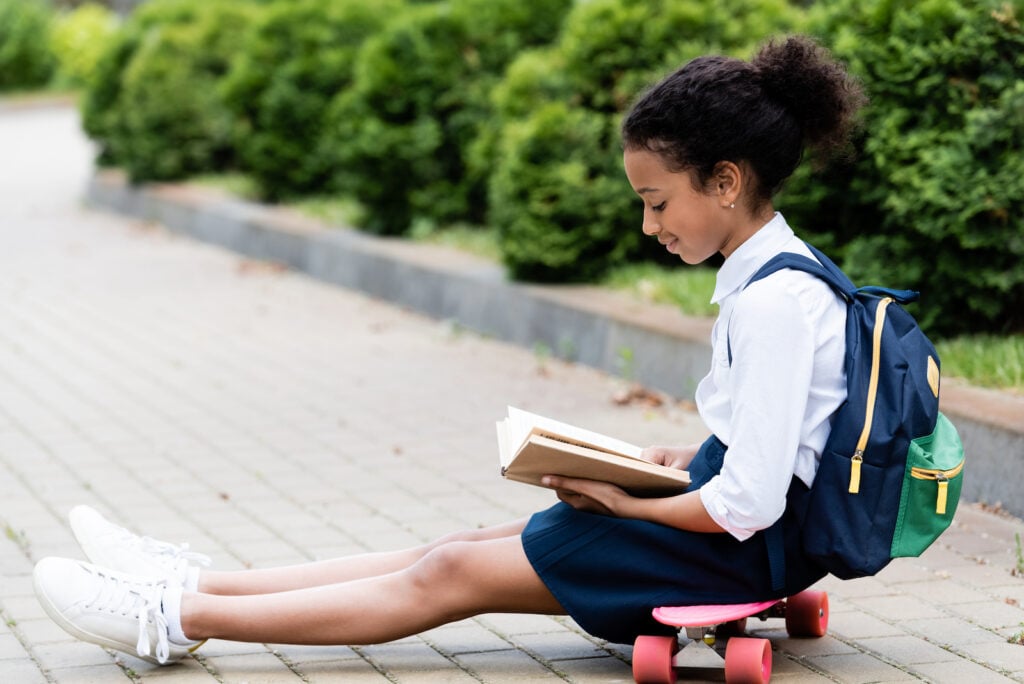Back to School Routine: Tips for Creating Structure and Predictability
Kids thrive on routine because it gives them a sense of predictability in their lives. Routines can help them feel like they have their needs met on a regular basis. With a back to school schedule for kids, they are able to depend on the sense of security they feel in a familiar way with their other routines.

When it comes to daily habits like sleeping and eating, most parents have probably had some kind of routine in place since their children were infants.
As children grow, new activities pop up, new patterns emerge, and new habits form. When regular routines are in place, kids can handle these changes with less stress.
Back to school is perhaps the biggest time of year for making adjustments to the family’s daily activities. Kids go from a relaxed (or non-existent) summer schedule to suddenly being expected to get up, dressed and out the door fairly quickly each day. There are new stressors and new transitions with added interactions and after-school activities.
How to establish a school routine
With the start of a new school year comes early mornings, busy schedules, and often some frustration as parents try to get everyone going in the right directions each day.
To take the hassles out of morning, evening, and after-school transitions, here are some tips for developing routines that work for your family and create smoother days.
Each child needs their own routine
Ask your child what they feel are the most important things to do. Talk together about what is working and what is not. Find out what the hardest parts of the morning are for them.
What do they need the most help with?
What can you expect them to accomplish on their own?
How much time is helpful for them to get ready?
When you include a child in the process of creating a routine, they are an active participant in it, rather than feeling like tasks are being imposed upon them. They have a sense of ownership in the process and are more likely to initiate the steps on their own.
Take time to ease in to the back to school routine
Start practicing a week or two before school starts. This gives kids a gradual introduction to what the mornings will look like as the school year approaches.
Start by just getting up at a slightly earlier time each day.
Then add in getting dressed before breakfast.
Finally, include breakfast, and by the time school starts, kids will have a solid feel for how the mornings will go.
Make the schedule visible
For everyday routines in which a lot of steps are involved, such as getting ready in the morning, after school responsibilities, or going to bed at night, it can be helpful to have a chart or a list. Having something tangible to post like a family command center on the wall is a handy reminder of what needs to be done every day without a parent having to nag.
Keep the chart simple—include the necessities without making the routine an overwhelming chore. Older children may do well with simply a written checklist on the back of their bedroom door or on the mirror in the bathroom. Young children do well with images or photos posted at their height so they can picture themselves completing each step of the routine.
Having the back to school routine posted is an easy reminder of what needs to happen.
Let the routine be the guide
Rather than direct kids through their tasks each day, refer to the chart or checklist to encourage kids to take initiative for their daily habits.
Ask your child, “OK, you’ve brushed your teeth, what comes next in your routine?”
Or, “What does the chart say you should be doing right now?”
Not only is a parent able to avoid nagging, but the child is able to start thinking proactively. Encouraging kids to take charge of their own routines gives them a much-needed sense of personal responsibility and self-sufficiency. They begin to take the lead in taking care of themselves.
Make connection part of your routine
Instead of starting your day with a flurry of activity and a rush to get out the door, try starting it with a few minutes of one-on-one time with your child. Often, this can make the difference between a morning of resistance and a morning of cooperation. Waking up just 10 minutes earlier to cuddle, talk, or read together in your child’s favorite chair starts the day from a place of harmony and connection.
You let your child know they are important, and that in that moment, you don’t have anywhere else to be—not work, not school, just right there in the moment with them. Then they feel closely connected to you, and they’re much more ready to face the day.
To further foster connection and ease, avoid screen time in the morning. Once kids get involved in a show or electronics, it’s often difficult to get them to shut down and go. If your children are ready early, encourage them to play or read until time to leave.
Celebrate successes
Acknowledge when kids complete tasks on their own and encourage them in sticking with their routines.
“I sure appreciate you being able to take your own shower while I get breakfast ready.”
Or, “You got yourself up today—yay!”
Or, “I noticed you put your shoes on at the same time you got dressed. That helps so much!”
Or, “This is the first time we haven’t had to rush through breakfast. It feels nice!”
Remember that this routine is something your child is expected to do as a cooperative member of the family, and issuing rewards for completing tasks will take away from their sense of pride and feelings of capability. Just continue to acknowledge their effort and appreciate their contributions in helping to get themselves ready and out the door on time.
With routines, children have an opportunity to learn to focus on the needs of the situation: doing what needs to be done because it needs to be done. This creates great feelings of capability, as well as eliminates opportunities for power struggles.
Sample Routine for School Children
Morning Routine for Kids
- Encourage children to take responsibility for getting themselves ready for the day. For small children, a chart of each step of the “getting ready” process can cut down on the number of reminders you have to give.
- Have a standard rotation of simple breakfast options, including a few “to go” items for those extra-crazy mornings. Crockpot oatmeal, toast, yogurt, cereal, and fruit are all easy, healthy choices. Muffins, bagels, or breakfast bars make good “to go” options.
- Associate tasks with specific times, such as what time you should be eating breakfast, and use a timer or cell phone alarm for reminders to get going. If you know you need to leave the house by 7:30, set an alarm to go off at 7:20 and again at 7:25 to prod you out the door.
- Padding extra time into the routine can save you from disaster, since anything from a missing shoe to a spilled milk cup can throw everything off schedule. Figure out how much time you really need to get out the door (time yourself for a week to get an accurate number), then add 15 minutes.
After-School Routine
- When kids get home, they’re usually hungry. Make healthy snacks easy by putting snack bins in the fridge and pantry so kids can help themselves. The pantry bin can hold trail mix, raisins and energy bars, while a fridge bin may have yogurt, fruit or other healthy snacks.
- Encourage kids to change out of school clothes as necessary, and hang up any uniform pieces that need to stay neat. If your kids have after-school activities, now is the time to change into appropriate clothing and be ready to go.
- If you like your kids to do their homework immediately after school, establish this routine from the first day and stick to it. Set up a homework station or keep supplies in a portable container if the dining table is being called into service.
Evening Routine for School Kids
- Check your calendar so school events, appointments, and meetings don’t sneak up on you. Also check your weather app, so you know if you’ll need cold weather gear, umbrellas, or extra sunscreen.
- Pack backpacks, musical instruments, or sports equipment the night before to ensure you have everything. Check your child’s homework and ensure their backpack is packed before bed, so permission slips, lunch money, gym clothes, and school projects aren’t forgotten.
- Prep for lunches the night before, and pack any snacks children need for school or after-school activities. Line up lunchboxes and reusable water bottles in the fridge to grab and go in the morning.
- Choose clothing the night before. Hang the outfit on the closet door knob so your child knows exactly what to wear.
- Help your child settle with a guided meditation before bed. Cool at School or Remember Easily are great options for elementary aged kids.
Routine for the First Few Weeks Back to School
If you have a sensitive child, or one who is still adjusting to school after the shut downs, they may need more reassurance with their new routine. Parenting coach, Mary Van Geffen shares these tips in an Instagram post about After School Restraint Collapse.
“It’s fatiguing to their allostatic load to keep it together all day despite all the strange customs, smells, sensations, novel instructions, social fears and lack of quiet or personal space.”
By the evening, their system cannot take anymore and they crumble. What can you do?
- Plan to play for 10 minutes after school on the playground with your child to ease the transition home.
- Bring water and a snack to pick up so at least the Hangry element is covered.
- Don’t ask “how was your day?”. Tell them, “it’s good to see you. I missed you” and then be quiet. Wait for them to be ready to talk rather than asking a bunch of questions. Try playing classical music on radio.
- Don’t take big emotions personally. These little people are going to be exhausted and likely melting down. Expect dysregulation and tantrums as a normal reaction to keeping up with behavioral expectations all day long.
- Make NO after school plans for the first few weeks. They need to be home experiencing free unstructured time with you close by.
When your child knows what to expect, they feel competent and accomplished, and they learn they have a cooperative place in the family. When fall approaches and schedules get busy with school and new activities, work with your children to establish a comfortable back to school routine that will help them succeed.

